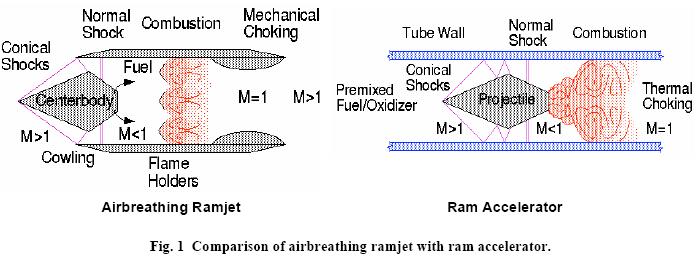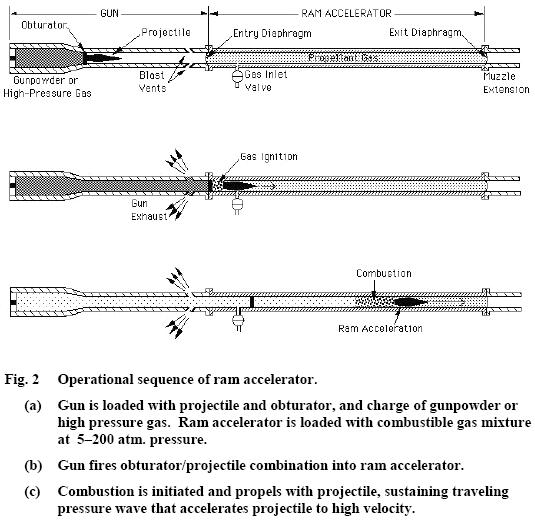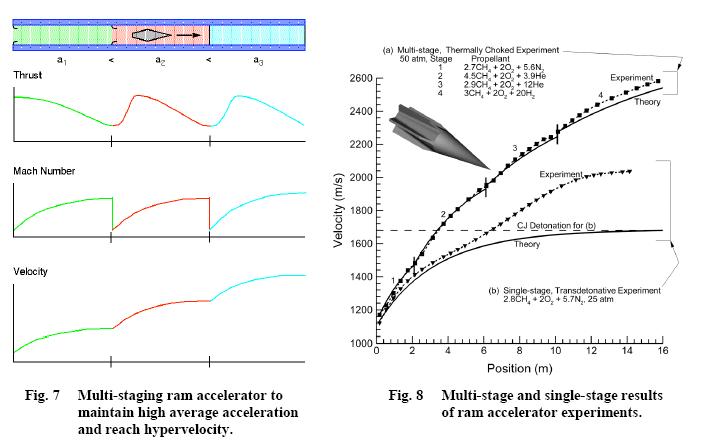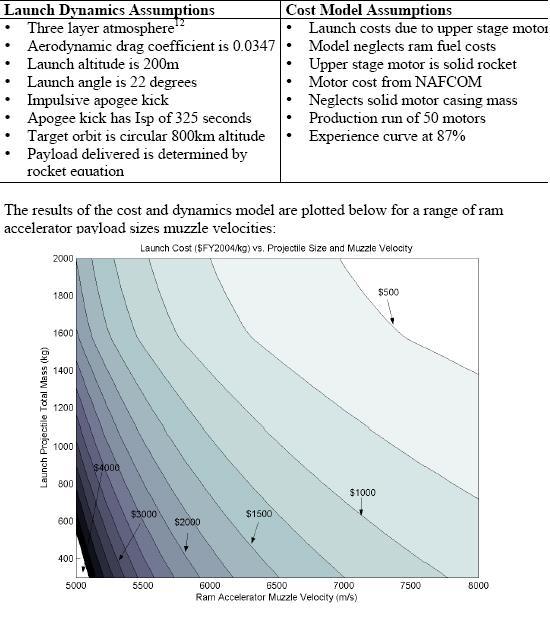New Scientist reports that John Hunter and two other ex-LLNL scientists have set up a company called Quicklaunch to make a light gas launch gun. The gun is larger than the Super High Altitude Research Project (SHARP) of the 1990’s, but is smaller and cheaper than what was proposed for the Jules Verne Launcher Company. Guns constructed by Hunter’s group included a 3 meter version that reached 8 km/s, and a 130 m gun that accelerated a 5 kg projectile to 3 km/s. This project was referred to as the Super High Altitude Research Project (SHARP), and an unsuccessful commercial spin-off was called the Jules Verne Launcher Company.
At the Space Investment Summit in Boston last week, Hunter described a design for a 1.1-kilometre-long gun that he says could launch 450-kilogram payloads at 6 kilometres per second. A small rocket engine would then boost the projectile into low-Earth orbit.
The gun would cost $500 million to build, says Hunter, but individual launch costs would be lower than current methods. “We think it’s at least a factor of 10 cheaper than anything else,” he says.
Hunter acknowledges that the projectile would be slowed by its passage through Earth’s atmosphere. But he says drag would be minimal on a pointy-nosed projectile, causing it to slow by only half a kilometre per second.
He also admits that the heat generated by the high-speed passage through the atmosphere is “like a welder’s torch”. However, it would be relatively short-lived, he says, with the projectile clearing the atmosphere in less than 100 seconds. Designing the projectile so that it could survive having some layers of its outer skin burned off would get around this problem, Hunter says.
Jules Verne Launcher Proposal
John Hunter had the Jules Verne Gun Company and they were trying to get funded in the mid-90s.
The full-scale gun would be bored into a mountain in Alaska for launches into high-inclination orbits. The gun would have a muzzle velocity of 7 km/second and fire 5,000 kg projectiles. The payload would be 1.7 m in diameter and 9 m long. Following burn of the rocket motor aboard the projectile, a net payload of 3300 kg would be placed into low earth orbit.
SHARP experience indicated maximum fire rate of the gun would be once per working day. A single gun could orbit over 1000 tonnes a year into orbit at a cost per kg one-twentieth of conventional rocket launchers. The economic breakeven point was calculated to be between the first 50 and 100 launches.
Payloads would be subjected to accelerations of about 1,000 G’s during launch, so Hunter recruited specialists to design prototype hardened satellite systems. JVL was apparently still operating in 1998, but no investors came forward to finance the multi-billion dollar development cost.
LEO Payload: 3,300 kg (7,200 lb). to: 185 km Orbit. at: 60.00 degrees.
Launch Price $: 2.000 million. in: 1996 price dollars.
Another cost estimate was 6.6 billion dollars.
The barrel of the full-scale version would be 3km (1.9 miles) long and have a calibre or diameter of 1.7m (1.9 yards). It might be permanently dug-in inside a mountain to launch satellites at a fraction of today’s rocket costs.
Popular Mechanics had a feature when the discussion was about 10-11 ton projectiles.
Ram Accelerators
Ram accelerators have been feature on this site. The Washington guys think they can build it for $40-50 million.
The ram accelerator is a chemically powered hypervelocity mass driver that operates with intube propulsive cycles similar to airbreathing ramjets and scramjets. The launcher consists of a long tube filled with a pressurized gaseous fuel-oxidizer mixture in which a subcaliber projectile having the shape similar to that of a ramjet centerbody is accelerated. No propellants for this launch process are carried aboard the projectile; it effectively flies through its own propellant “tank”. The ram accelerator at the University of Washington has been operated at velocities up to nearly 3 km/s and in-tube Mach numbers greater than 7 in methane-based propellant mixtures. This Mach number capability corresponds to muzzle velocities greater than 7 km/s when using fuel-rich hydrogen-oxygen propellant. The combination of hypervelocity muzzle velocities and the ram accelerator’s inherent scalability to multi-ton payload sizes makes it suitable for direct space launch.
Although it resembles a conventional long-barreled cannon, the principle of operation of the ram accelerator is notably different, being closely related to that of a supersonic airbreathing ramjet engine.
The total propellant mass used per ram accelerator launch to 8 km/s is
~20 times the mass of the projectile; e.g., ~40 metric Tons for a 2000 kg projectile.

Comparison to air breathing rocket

The firing sequence of a ram accelerator

Different from a regular big gun

Multiple stages of acceleration

Projectile mass and launch speed determine the cost per kilogram
Baffle tube ram accelerator (2005)
Nuclear Cannon
This site has previously presented the concept of the one underground pulse nuclear launch cannon. It is reconfiguring Project Orion into a one pulse true nuclear space cannon with no atmospheric detonations. Only underground detonation like was done Amchitka Island in Alaska. Most of the nuclear test ban can stay in place. The Threshold test ban only comes into effect when scaling up past the 150 kiloton underground test or launch. The Comprehensive test ban (1996) which would ban underground tests has not been ratified by the USA yet. The concept needs to use underground explosion for peaceful purposes. After reviewing the idea, we will look at the details of underground nuclear explosions.
One post presents the basic idea of the one pulse cannon and
Briefly Reviewing the One Underground Pulse Nuclear Launch Cannon
The light gas gun and ram accelerator work shows that smaller projectiles could be launched and survive the forces of launching and mostly be constructed to survive the passage through the atmosphere. A 150 kiloton nuclear cannon launch could deliver several thousand tons to orbit which would be more than the annual launch volume of the light gas gun or ram accelerator proposals.
I have an analysis of using a one pulse Orion like configuration to launch 100,000 to 200,000 tons of cargo to Orbit or the moon using one 10 megaton explosion. 150 kilotons which is allowed under the Threshold test ban could probably launch 500-1000 tons. Chemical rockets would take $1-5 trillion to launch that much cargo into space. Even assuming super-high volume chemical rocket costs could be reduce by ten times, this would still be a $100 billion to 500 billion value. (fuel, water, metals and any other gravity hardened material.)
10 Megatons of TNT, equal to 4.185×10^16 Joules (1 ton of TNT = 4.185×10^9 Joules, One Joule is one kilogram/M^2/S^2 )The average power produced during the entire fission-fusion process, lasting around 39 nanoseconds, was about 1.1×10^24 watts or 1.1 yottawatts. Configuring a nuclear device the way project Orion had planned would direct 85% if the energy at the pusher plate.
so 3.5*10^16 Joules towards kinetic energy.
Kinetic Energy =1/2*Mass*Velocity^2
Escape velocity=11186 M/S
EV ^ 2 = 125 million (m^2/s^2)
2.8*10^8 kg or 280,000 tons. Say 140,000 tons to double escape velocity if we wanted to be pretty sure that the projectile cargo could go the moon if we aimed it right.
It is a modification of the old underground nuclear tests. Repeating the old 5-10 megaton tests, but reconfigure to optimize conversion to kinetic energy as per the
Project Orion, Pascal-A/B, Thunderwell and Casaba-Howitzer work. Radiation containment for underground tests is a known problem and demonstrated by actual US and Russian tests.

This chart of space velocities corrects some previous information that I had for the nuclear cannon
Sacrifice one salt dome or an area under an island. Salt dome is easier to make a large diameter shaft for the projectile. Using natural geological feature mostly reduces cost of containment and has been demonstrated historically.
Actual out of pocket cost could be less than one billion dollars. Can be done within 2 years. Supercomputer modeling would be needed to get everything to work properly.
Very limited technical risk for the launch. Nuclear bombs work. Leverages the trillions spent on the arms race for good. (sunk costs)
Need to get some support from notable people who already support Project Orion.
Can we get George Dyson, Freeman Dyson or other old-timers to look at this idea and
see if they like it ? How much support if there is no airbursts, no dangerous EMP, and no atmospheric radiation but just vastly superior unmanned space launch capability. Negotiate for the exception to the comprehensive test ban. Maybe allow Russia, China, UK and France and other to share the payload that is delivered or for each to be allowed to launch one.
If the nuclear cannon jump started a real space program.
Eros has a lot of gold and platinum in it. Perhaps a $100 trillion plus at $1000/ounce. The issue would be how much could be mined in a year and how would it effect market prices. Eros is shaped like a 33 km by 13 km by 13 km banana.
There is $100 billion in resources for every person on earth in the asteroids.
FURTHER READING

Brian Wang is a Futurist Thought Leader and a popular Science blogger with 1 million readers per month. His blog Nextbigfuture.com is ranked #1 Science News Blog. It covers many disruptive technology and trends including Space, Robotics, Artificial Intelligence, Medicine, Anti-aging Biotechnology, and Nanotechnology.
Known for identifying cutting edge technologies, he is currently a Co-Founder of a startup and fundraiser for high potential early-stage companies. He is the Head of Research for Allocations for deep technology investments and an Angel Investor at Space Angels.
A frequent speaker at corporations, he has been a TEDx speaker, a Singularity University speaker and guest at numerous interviews for radio and podcasts. He is open to public speaking and advising engagements.


